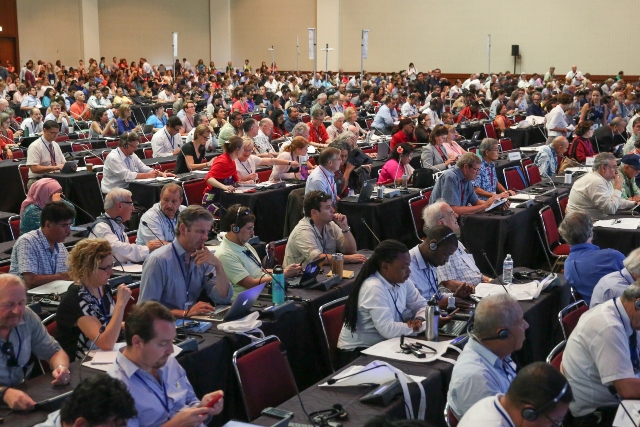Planet at the crossroads
Held every 4 years, the IUCN World Conservation Congress is a unique event - the world’s largest and most democratic conservation event that brings together the expertise of its powerful membership to address the most pressing issues of the time. It has two parts: a marketplace of ideas called the Forum and a voting session for IUCN Members called the Members’ Assembly.
Themed ‘Planet at the crossroads’ the 2016 IUCN Congress was held in Hawai’i in September, and has without doubts been the most successful one with a record attendance of more than 10,000 participants. It came at a crucial time for our Planet, calling for decisions and action as we reach the crossroads facing challenges of unprecedented magnitude. The ecosystems that underpin our economies, well-being and survival are collapsing. Species are becoming extinct at alarming rates. Our climate is in crisis. In 2015, almost 200 nations agreed on ambitious goals for sustainable development and achieving climate neutrality. These agreements represent an historic opportunity to improve the lives of billions of people around the globe and put nature at the heart of our decisions. Time has come to move these agreements into action.
The IUCN Congress gathered leaders from government, civil society, indigenous, faith and spiritual communities, the private sector, and academia, to collectively decide on actions to address the most pressing conservation and sustainable development challenges. Joint decisions were presented as the Hawai'i Commitments, a document titled “Navigating Island Earth”. It outlines opportunities the Humanity has and brings the collective commitment by all who attended the Congress to undertake profound transformations in how human societies live on Earth, with particular attention to making our patterns of production and consumption more sustainable. Key decisions included closure of domestic markets for elephant ivory, the urgency of protecting the high seas, the need to protect primary forests, no-go areas for industrial activities within protected areas and an official IUCN policy on biodiversity offsets.
Some of the flagship initiatives presented and launched at the IUCN Congress are:
A globally agreed standard for the methodology for identification of Key Biodiversity Areas – a significant step that consolidates the joint approach to conservation globally. CBD and other global processes will promote KBAs as the methodology, and countries will also follow this approach. In Europe, countries will continue to follow the Natura 2000 principles.
The IUCN Red List of Ecosystems Categories and Criteria is a global standard for how we assess the conservation status of ecosystems, applicable at local, national, regional and global levels. The reliable assessments of ecosystem status will raise awareness about threats to ecosystems and the resulting impacts on human well-being, as well as demonstrating how improved ecosystem management can reduce risks, enhance resilience, and promote adaptation. The Red List of Ecosystems will inform better management of the finite resources of our planet.
The IUCN Green List of Protected and Conserved Areas is a new global standard for protected areas that is already now applied in several countries (France, Italy, Colombia, China, soon Croatia and Georgia). The objective of this process is to form a contact group on the state level that would analyze the protected areas according to the criteria, including the management efficiency.
- Protected Planet Report 2016 (UNEP-WCMC and IUCN)
This report provides a comprehensive assessment on the status of the global protected area network and recommends investing in protected areas to strengthen sustainable management of fisheries, control invasive species, cope with climate change and reduce harmful incentives. It highlights current research and case studies as examples of the role protected areas play in conserving biodiversity and cultural heritage. Close to 15% of the Earth's land and 10% of its territorial waters are covered by national parks and other protected areas; coverage of marine protected areas increased by almost 300% in the last decade. But the report also shows that crucial biodiversity areas are being left out, key species and habitats are underrepresented and inadequate management is limiting the effectiveness of protected areas.
One of the new resolutions requests IUCN to engage on the definitions and improvement of new standards on ecotourism (#065), as well as to create and deliver training opportunities for ecotourism governance, and the implementation of best practices for ecotourism development and management.
The latest update of The IUCN Red List of Threatened Species™ released at the IUCN Congress reports that four out of six great ape species are now Critically Endangered, but also brings some good news and shows that conservation action is delivering positive results. Previously listed as Endangered, The Giant Panda is now listed as Vulnerable, while the tiger population is growing for the first time in our recent history.


